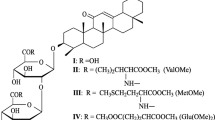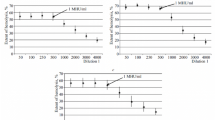Summary
-
(1)
In adult individuals the response to bacterial antigen usually has the character of a secondary reaction and is not influenced even by large doses of 6-mercaptopurine. The effect of 6-mercapto-purine on antibody response was therefore studied in young rabbits, in which a primary reaction is produced. It was found that doses of 0.3 and 0.5 mg./ 100 g. body weight led to complete inhibition of the antibody reaction after the injection ofSalmonella paratyphi B andBrucella suis antigen.
-
(2)
The phase of antibody formation influenced by 6-mercaptopurine was determined by transferring isolated spleen cells mixed with antigenin vitro to young rabbits. In all the experiments, 6-mercaptopurine was administered to the recipients subcutaneously in doses of 0.5 mg./ 100 g. for five days. If the administration of 6-mercaptopurine was initiated immediately after the transfer of normal cells mixed with antigenin vitro, antibody formation was completely inhibited. If the transferred cells were isolated from the donor during the phase of antibody production, however, the same doses of 6-mercaptopurine failed to inhibit the antibody reaction. Antibody formation was likewise not inhibited when the administration of 6-mercaptopurine was not begun until 72 hours after the transfer of normal cells mixed with antigenin vitro. When 6-mercaptopurine was administered 24 and 48 hours after transfer of the cells the antibody response was completely inhibited. This part of the experiments shows that 6-mercaptopurine is effective during the inductive phase of antibody formation only.
-
(3)
When 6-mercaptopurine was administered to one-month-old rabbits over a period of 14 days, during which 60 ml. blood and 500×106 spleen cells from an adult donor were administered, tolerance to a skin homograft from the corresponding donor was not induced.
Abstract
-
(1)
у взрослых особей реакция на бактериальный антигеп имеет характер преимущественно вторичной реакции, а 6-меркаптопурин не окаэывает на нее влияния даже в больших дозах. Поэтому мы исследовали вопрос, влияет ли 6-меркаптопурип па реакцию обраэоваторых он выэывает первичную реакцию. Мы установили, что дозы в 0,3 и 0,5 мг/100 г веса тела выэывают полное торможение реакции обраэовання антител после влрыскивания антигенов Salmonella paratyphi B и Brucella suis.
-
(2)
Мы иселедовали вопрос, на какие этапы обраэовапия антител действует 6-меркаптопурин. Для этого мы полъэовалисъ переносом молодым крольчатам изолиых с антигеном in vitro. 6-меркаптопурин мы вводили реципиентам под кожу в количестве 0,5 мг/100 г веса тела-во всех опытах всегда в теченне 5 дней. Если введение 6-меркаптопурина пачипается пемедленно послеперепоса нормалъных клеток, смешапных с аптигеном in vitro, наблюдается полное угнетение обраэования антител. Однако те же доэы 6-меркаптопурина не тормоэят реакции обраэоапия антител, если перенести молодым животным клетки, выделенные в период продукции антител. Введение 6-меркаптопурина не тормоэит также образовапия антител, сели после переноса нормальных клеток, емешаппых с аптигепом in vitro, его введение начинается толъко череэ 72 часа после переноса клеток. Если 6-меркаптопурин водить через 24 или 48 час. После переноса клеток, реакция образования анител оказывается полностью заторможенной. Эта чаеть опытов Докаэывает, что 6-мркаптопурин действует только в течение индуктивной ϕаэы обраэования антител
-
(3)
Введение 1-месячным крольчатам 6-меркаптопурина в течение 14 дней, в течение которых им было введено 60 мл крови от взрослого донора и 500?106 клеток селезенки, не соэдавало толерантности к кожному гомотранснлантату от соответственного донора.
Similar content being viewed by others
References
Axelrod, A. E., Pruzansky, J.:The role of the vitamins in antibody production. Vitamins and Hormones 13: 1, 1955.
Benjamin, E., Sluka, E.:Antikörperbildung nach Schädigung des hämopoetischen Systems durch Böntgenstrahlen. Wien. klin. Wschr. 21: 311, 1908.
Berglund, K., Fagraeus, A.:Effect of cortisone on antibody formation. Atti del VI. Congr. Intern. Mierobiol. 2: 231, 1953.
Biesele, J. J.:Antagonistic effects of 6-mercaptopurine and coenzyme A on mitochondria and mitosis in tissue culture. J. Biophys. and Biochem. Cytol. 1: 119, 1955.
Bjorneboe, M., Fischel, E. E., Stoerk, H. C.:The effect of cortisone and adrenocorticotrophic hormone on the concentration of circulating antibody. J. exp. Med. 93: 37, 1951.
Bolton, E. T., Mandel, H. G.:The effects of 6-mercaptopurine on biosynthesis in Escherichia coli. J. biol. Chem. 227: 833, 1957.
Broekman, R. W., Sparks, M. C., Simpson, M. S.:A comparison of the metabolism of purines and purine analogs by susceptible and drug-resistant bacterial and neoplastic cells. Biochim. biophys. Acta 26: 671, 1957.
Brodehl, J.:Her Einfluss des Triäthylenmelamins auf die Antikörperbildung Z. Immunforsch. 113: 343, 1956.
Dameshek, W.: In report on:Radiation protection and marrow transplantation. Lancet 1: 330, 1960.
Davidson, J. D., Freeman, B. B.:Investigation of diverse systems for cancer chemotherapy screening. XVIII. The effects of compounds upon P32 incorporation into nucleic acids as a technic for selecting antitumor drugs. Cancer Research, suppl. 3: 97, 1955.
De Vries, A.:The effect of adrenocorticotrophic hormone on circulating antibody levels. J. Immunol. 65: 1, 1950.
Dixon, F. J., Talmage, D. W., Maurer, P. H.:Radiosensitive and radioresistant phases in the antibody response. J. Immunol. 68: 693, 1952.
Dixon, F. J., Maurer, P. H.:Immunologic unresponsiveness induced by protein antigens. J. exp. Med. 101: 245, 1955.
Elion, G. B., Singer, S., Hitchings, G. H.:The purine metabolism of a 6-mercaptopurine-resistant Lactobacillus casei. J. biol. Chem. 204: 35, 1953.
Elion, G. B., Hitchings, G. H.:Metabolism of S-C 14 adenine by a 6-mercaptopurine resistant strain of Lactobacillus casei. Fed. Proc. 13: 203, 1954.
Elion, G. B., Balis, M. E.:Effect of 6-mercaptopurine on the interconversion of purine moieties in Lactobacillus casei. Fed. Proc. 14: 207, 1955.
Felton, L. D.:The significance of antigen in animal tissuesun. J. Immunol. 61: 107, 1949.
Fernandes, J. F., LePage, G. A., Lindner, A.:The influence of azaserine and 6-mercaptopurine on the in vivo metabolism of ascites tumor cells. Cancer Res. 16: 154, 1956.
Garver, R. M., Santos, G. W., Cole, L. J.:Specific hemagglutiniu in X-irradiated, bone-marrow treated mice following differential immunization of host and donor. J. Immunol. 83: 57, 1959.
Green, D. M.:The effect of nitrogen mustard on the immunological response of the rabbit. I. The effect of nitrogen mustard on the primary response to a bacterial antigen. Brit. J. exp. Path. 39: 192, 1958a.
Green, D. M.:The effect of nitrogen mustard on the immunological response of the rabbit. II. The effects of nitrogen mustard, on the breakdown of a bacterial antigen in splenic tissue. Brit. J. exp. Path. 39: 213, 1958b.
Hakala, M. T., Nichol, Ch. A.:Studies on the mode of action of 6-mercaptopurine and its ribonucleoside on mammalian cells in culture. J. biol. Chem. 234: 3224, 1959.
Hanan, R., Oyama, J.:Inhibition of antibody formation in mature rabbits by contact with the antigen at an early age. J. Immunol. 73: 49, 1954.
Haurowitz, F., Crampton, C. F.:The role of nucleus in protein synthesis. Exp. Cell. Res., suppl. 1952.
Hoyer, L. W., Condie, R. M., Good, R. A.:Prevention of experimental allergic encephalomyelitis with 6-mercaptopurine. Proc. Soc. exp. Biol. Med. 103: 205, 1960.
Kaliss, N., Hoecker, G., Bryant, B. F.:The effect of cortisone on isohemagglutinin production in mice. J. Immunol. 76: 83, 1956.
Karush, F.:Specificity of antibodies. Trans. N. Y. Acad. Sci. 20: 581, 1958.
Kryukova, I. N.:Acquired tolerance to heterologous serum in rats. Byul. eks. biol. med. 43: 78, 1957.Крюкова, И. Н.: Вюл эке. Биол. Мед. 43: 78, 1957.
LaPlaute, E. S., Condie, R. M.:Prevention of secondary immune response with 6-mercaptopurine. Fed. Proc. 19: 138, 1960.
Lutsenko, T. A., Markitanova, A. E.:The effect of novoembikhin on complement and on agglutinin and precipitin production in animals. Byul. eks. biol. med. 43: 89, 1957.Лутсенко, Т. А., Маркчтанова, А. Е.: Вюл. эке. биол. мед. 43:89, 1957.
Makinodan, T., Friedberg, B. H., Tolbert, M. G., Gengozian, N.:Relation of secondary antigen injection to time of irradiation on antibody production in mice. J. Immunol. 83: 184, 1959.
Makinodan, T., Gengozian, N.:X-ray depression of the recognition mechanism of antibody-forming cells. Proc. Symp. Mechanisms of Antibody Formation, Prague 1960.
Medawar, P. B.:A second study of the behaviour and fate of skin homografts in rabbits. J. Anat. 79: 157, 1945.
Meeker, W., Condie, R., Weiner, D., Varco, R. L., Good, R. A.:Prolongation of skin homograft survival in rabbits by 6-mercaptopurine. Proc. Soc. exp. Biol. 102: 459, 1959.
Pauling, L.:A theory of the structure and process of formation of antibodies. J. Amer. chem. Soc. 62: 2643, 1940.
Phillips, F. S., Hopkins, F. H., Freeman, M. L. H.:Effect of tris- (betachlorethyl) amine on antibody production in goats. J. Immunol. 55: 289, 1947.
Puck, T. T., Marcus, P. I.:Action of X-rays on single mammalian cells. J. exp. Med. 103: 653, 1956.
Salvin, S. B., Smith, R. F.:Delayed hypersensitivity in the development of circulating antibody. The effect of X-irradiation. J. exp. Med. 109: 325, 1959.
Salvin, S. B., Smith, R. F.:The specifity of allergic reactions. I. Delayed versus Arthus hypersensitivity. J. exp. Med. 111: 465, 1960.
Shamaeva, E. M., Pankova, S. S.:The effect of novoembikhiine on the formation of antibodies (haemolysins and haemagglutinins.) ZhMEI 28/4/: 25, 1957.Шамаева, Е. М., Панкова, С. С.: Жмеи 28:25, 1957.
Schwartz, R., Stack, J., Dameshek, W.:Effect of 6-mercaptopurine on antibody production. Proc. Soc. exp. Biol. 99: 164, 1958.
Schwartz, R., Eisner, A., Dameshek, W.:The effect of 6-mercaptopurine on primary and secondary immune responses. J. Clin. Invest. 38: 1394, 1959.
Schwartz, R., Dameshek, W.:Drug-induced immunological tolerance. Nature 183: 1682, 1959.
Skipper, H. E.:On the, mechanism of action of 6-mercaptopurine. Ann. N. Y. Acad. Sci. 60: 315, 1955.
Skipper, H. E., Thompson, J. R., Hutchison, D. J.:Anticancer activity of purine antagonists and their ribosides. I. Comparative studies with 6-mercaptopurine and 6-mercaptopurine-riboside. Proc. Soc. exp. Biol. 95: 135, 1957.
Šmahel, O., Šmahelová, R.:Vliv dusíkatého yperitu na tvorbu protilátek. Čas. lék. čes. 91: 733, 1952.
Šterzl, J.:Nucleoprotein origin of antibodies. Riassunti Comm. VI. Congr. Intern. Microbiol. 3: 344, 1953.
Šterzl, J.:Obranné pochody v organisrau. Nakl. Čs. akad. věd, Praha 1954.
Šterzl, J.:The demonstration and biological properties of the tissue precursor of serum antibodies. Fol. biol. (Praha) 1: 193, 1955.
Šterzl, J.:Long-term immunization. I. The inhibition of antibody formation in daily immunization. Čs. mikrobiol. 1: 7, 1956.
Šterzl, J.:The production of antibodies by isolated spleen cells following contact with an antigen in vitro. Fol. biol. (Praha) 3: 1, 1957.
Šterzl, J.:Study of the inductive phase of antibody formation in tissue culture. Fol. microbiol. 4: 91, 1959a.
Šterzl, J.:The inductive phase of antibody formation. Uspyekhi sovremenoi biol. 48: 356, 1957b (Шмериль, Я.: Успехи современой биол. 48: 1957ь).
Šterzl, J.:The inductive phase of antibody formation. Proc. Symp. Mechanisms of Antibody Formation, Prague 1960a.
Šterzl, J.:Prvé stupně tvorby protilatek. Stát. zdrav. nakl., Praha 1960b.
Šterzl, J., Holub, M.:Vliv 6-merkaptopurinu na tvorbu protilátek. Čs. biol. 6: 75, 1957.
Šterzl, J., Holub, M.:The influence of 6-mercaptopurine on antibody formation. Fol. biol. (Praha) 4: 59, 1958.
Šterzl, J., Hrubešová, M.:Přenos tvorby protilátek nukleoproteidovými fralccemi na neimunisované přijemce. Čs. biol. 4: 600, 1955.
Šterzl, J., Hrubešová, M.:The transfer of antibody formation by means of nucleoprotein fractions to non-immunized recipients. Fol. biol. (Praha) 2: 21, 1956.
Taliaferro, W. H., Taliaferro, L. G.:The role of the spleen in hemolysin production in rabbits receiving multiple antigen injections. J. Infect. Dis. 89: 143, 1951a.
Taliaferro, W. H., Taliaferro, L. G.:Effect of X rays on immunity. J. Immunol. 66: 181, 1951b
Author information
Authors and Affiliations
Rights and permissions
About this article
Cite this article
Šterzl, J. Study of antibody formation by the use of metabolic inhibitors. Folia Microbiol 5, 364–373 (1960). https://doi.org/10.1007/BF02927187
Received:
Issue Date:
DOI: https://doi.org/10.1007/BF02927187




